Source: The Strolling Astronomer, Journal of the Association of Lunar and Planetary Observers, Volume 39, Number 3, pp. 135-138, February 1997.
Abstract
From time to time reports have appeared in the literature describing fast-moving objects (FMOs) moving across or near the lunar surface. Typically, these take the form of either light or dark spots, with apparent velocities of 0.001-0.1 deg./sec. and a duration under one minute. We have evaluated the hypothesis that such phenomena are of terrestrial origin and only appear projected against the Moon by chance. Statistical analysis, however, reveals a significant excess of sightings in the Mare Imbrium area relative to the Mare Nectaris-Foecinditatis area. These unexpected results, as well as the trajectory angle of some of these objects, imply that FMOs may be of lunar origin. Clearly, further systematic patrols are warranted.
Introduction
This article addresses the phenomenon of sporadic, fast-moving objects (FMOs) which reportedly appear and disappear across and near the lunar disc. Observations of birds, insects, terrestrial meteors, and so forth that occasionally pass across the line of sight have naturally been excluded from this analysis. FMOs have been reported by a number of prominent observers, including Schroeter (1791), Schafarik (1885), Haas (1947) and Firsoff (1960). They have been listed in the NASA Lunar Transient Phenomena Catalogue (Cameron 1978).
Scharfarik (1885) emphasized the difference between terrestrial meteors and the star-like FMOs in the following report:
"In class I, I should place an object of so peculiar a character that I do not know what to make of it. 1874, April 24, at about 3 1/2 h.p.m. I observed the moon (illuminated nearly 3/4 in bright sunshine, with power 66, field 34', of a fine 4-inch achromatic by Dancer, when I was surprised by the apparition, on the disc of the moon, of a dazzling white star, which traveled slowly from E.S.E. to W.N.N., and after leaving he bright disc, shone on the deep blue sky like Sirius or Vega in daylight and fine air. The star was quite sharp and without a perceptible diameter... It was absolutely sharp, and its flight so slow (about 5 s.) that even a trace of indistinctness would have been perceptible."
Haas (1947) argued that fast-moving lunar objects exhibited properties statistically different from those of terrestrial meteors, particularly with respect to their short path lengths and small angular dimensions. In the 1940's, he thought that meteors could actually be observed in the lunar atmosphere, although it is now clear that such an atmosphere is far too rarefied for this to occur. It is primarily for that reason that most modern observers a priori favor a terrestrial explanation for FMOs. This postulate can be usefully tested, however.
FMO Categories
Although the author has collected reports of fast-moving objects on the Moon for many years, including observations recorded in the literature as well as direct correspondence with individual observers, to date only 114 cases have been compiled. Reports of FMOs are indeed rare and comprise only about 5 percent of current reported lunar Lunar Transient Phenomena (LTP). From an analysis of the available LTP reports, Arkhipov (1994a) recognized three types of moving objects:
Only the latter category constitutes a sample large enough to warrant statistical evaluation. Accordingly, only FMOs whose duration and location on the lunar surface have been reported were selected for the analysis (see Table 1, p. 136). In Table 1: Xi=cos (latitude[i]) x sin (longitude[i]); Yi= sin (latitude [i]); the rectangular coordinates of the starting (i = 1) or the terminal (i = 2) points of the FMO trajectories; n = the number of objects or clusters of objects; t = duration of the event; * = personal communication with the observer (from the author's files, unpublished).
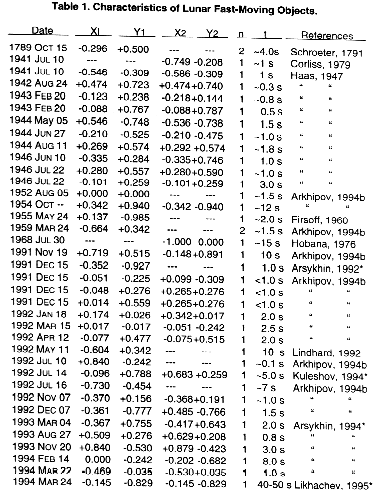
|
Note: The author has not seen FMOs personally. The reference 'Arkhipov 1994b' is a catalog of FMO events which were reported by various observers.
Table 1: FMO Distribution on the Moon
Since only 66 usable data points were available from our list, a contour-smoothing technique had to be utilized to demonstrate FMO distribution patterns across the lunar surface. The number (k) of points inside a circle with a circle of 0.3 lunar radii was calculated. This procedure was applied by scanning the entire lunar disc with this circle. For every position of the circle center, the ratio (f) of k and its average value were calculated. The resulting map of the f parameter is shown in Figure 1 (p.137).
The only statistically significant feature on the map is the excess of points in the Mare Imbrium region (A) relative to the Mare Nectaris-Mare Foecunditatis region (B). Indeed, 19 data points fall inside the f=1.5 contour of Region A. The area within this contour constitutes 0.131 of the entire visible lunar disk. The probability that >19 points would fall within this contour by chance on the basis of the binominal distribution is found as follows:

|
where M=19 and N=66. This gives a probability of 0.0006. With respect to Region B only one data point falls within the f<0.5 radius, yeilding a probability of <1 point inside this area, comprising 0.148 of the visible surface, of WB=0.0003. Obviously these calculated probabilities are sufficiently low to contradict the expected uniform distribution of FMO events should they be of terrestrial origin.
The apparent correlation of FMO events with certain lunar regions for what are presumably random events is certainly unusual, however, possible selection effects must also be considered.
First, it is possible that the probability of observing lunar meteors is affected by the albedo of the lunar background. The ratio of the visual albedo of the brightest crater Aristarchus to the darkest Grimaldi, is only 3 or a magnitude difference of 1.19 (Fessenkov, 1962). The cumulative number of meteors brighter than magnitude m is proportional to 10(0.3*m) for -10<m<+10 (Astapovich, 1958). Consequently, the background effect cannot account for the differences in meteor visualization by a factor of 100.3*1.19 or 2.28 times. The average value of the f-parameter is M/Np=2.20 in Region A (where f>1.5). Clearly the lunar background differences cannot account for a 22-fold difference.
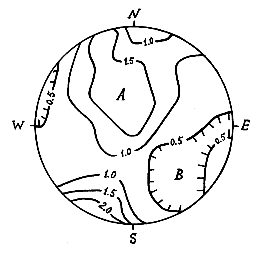
|
Figure 1: Contour map of the relative density (f) of the start & end points of FMO trajectories across the lunar disk, where 1.0 is the mean of f. The selenographic orientation is also indicated.
Second, some regions of the Moon might be observed more frequently due to favorable solar illumination and the restricted field of view of the telescope. However, lighting conditions should be identical for the lunar Southern and Northern hemispheres, yet there is asymetry with respect to the distribution of points; 39 in the north and 25 in the south. The probability of such a difference being due to chance is 0.052 (M=39; N=64; p=0.5), implying at a 95 percent confidence level that the north-south asymetry is real. in addition, most observers whose data were analyzed here, used small telescopes with low magnification, and thereby examined almost the entire lunar disk. Conceivably, the search for LTP in the Plato region could draw an observer's attention towards Mare Imbrium, resulting in an unintentional bias toward observing that area. However, Aristarchus, the "Mecca" of all LTP hunters (Cameron 1977), is outside region A, suggesting such a bias is in fact unimportant in this context. Collectively, the above indicate that biased selection effects do not explain the reported asymmetry in FMO distribution patterns.
Finally, some FMOs exhibit curved, nonmeteoric trajectories. Let me cite one such original report. On 1995 AUG. 15, using a small refractor, Yaremenko (1983) stated: "A luminous body similar to a 3rd magnitude star flew at about 0.2 lunar radii above the disk, parallel to its edge (limb). The body flew about a third of the circumference (it continued for 4-5 seconds) and [apparently] landed on the lunar surface with a steep trajectory." his drawing is reproduced in Figure 2. Similar examples of paths are shown in Figure 3-5 (p. 138). Although curved trajectories are very rare events, they must be taken into account.
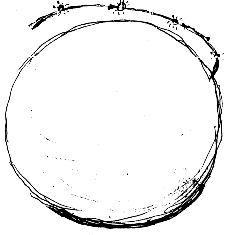
|
Figure 2: The circular trajectory of a starlike object near the lunar limb observed by V.V. Yaremenko, in mid-August, 1955 at about 17h00m UT, from Novocherkask, USSR, with a home-made refracter (aperture and magnification not given). Original drawing by the observer.
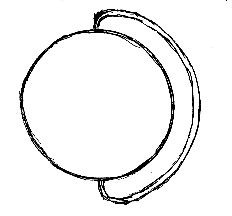
|
Figure 3: Trajectory of white line circling the Full Moon for 5-6 s before merging with the lunar surface. This phenomenon was observed in October or November, 1954-55 with the naked eye by V.I. Timkov from Ordjonikidze, USSR. Drawing by observer.
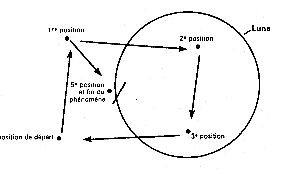
|
Figure 4. The curious trajectory of a starlike object near the crescent Moon, observed on 1968 Jul by M. Beres from Tusnad-Bai, Rumania (Hobana and Weverbergh, 1976). The object appeared to disappear behind the Moon. (No telescope or other details given.)
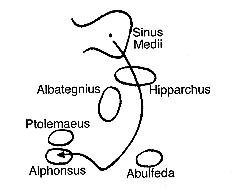
|
Figure 5: The twisted trajectory of a dark object observed by E.V. Arsykhin on 1992 Mar 15, 16h45m UT and lasting about 2.5 s. Observed with a 65-mm Newtonian from Moscow, Russia. Drawing by observer.
Conclusions
Reports about lunar FMOs clearly warrant serious attention. It can be argued that at least some FMOs occupy circumlunar locations, but clearly more data are needed before this can be verified. The author would greatly appreciate receiving reports about any moving phenomena in the vicinity of, or over, the lunar disk. Please contact: Alexey V. Arkhipov, Institute of Radio Astronomy, 4, Krasnoznamennaya St., Kharkov 310002, Ukraine.
Acknowledgements
The author is very grateful to Winifred S. Cameron, David C. Darling, Francis G. Graham, Gerald H. North, David J. Robinson, and John E. Westfall for their help with the literature. I also wish to thank E.V. Arsykhin, I.S. Brukhanov, N.V. Kuleshov, N.V. Likhachev, V.I. Timkov, and V.V. Yaremenko for their personal communications about their FMO observations.
References